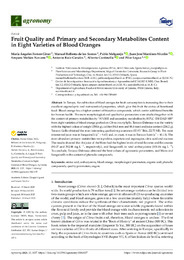Por favor, use este identificador para citar o enlazar este ítem:
https://hdl.handle.net/11000/31000Registro completo de metadatos
| Campo DC | Valor | Lengua/Idioma |
|---|---|---|
| dc.contributor.author | Forner-Giner, M. Angeles | - |
| dc.contributor.author | BALLESTA DE LOS SANTOS, MANUEL | - |
| dc.contributor.author | Melgarejo Moreno, Pablo | - |
| dc.contributor.author | Martínez Nicolás, Juan José | - |
| dc.contributor.author | Melian Navarro, Amparo | - |
| dc.contributor.author | Ruíz Canales, Antonio | - |
| dc.contributor.author | Continella, Alberto | - |
| dc.contributor.author | Legua, Pilar | - |
| dc.contributor.other | Departamentos de la UMH::Economía Agroambiental,Ing. Cartográfica y Expresión Gráfica en la Ingeniería | es_ES |
| dc.date.accessioned | 2024-02-05T08:12:16Z | - |
| dc.date.available | 2024-02-05T08:12:16Z | - |
| dc.date.created | 2023-03 | - |
| dc.identifier.citation | Agronomy, 13 (2023) | es_ES |
| dc.identifier.issn | 2073-4395 | - |
| dc.identifier.uri | https://hdl.handle.net/11000/31000 | - |
| dc.description.abstract | In Europe, the cultivation of blood oranges for fresh consumption is increasing due to their excellent organoleptic and nutraceutical properties, which give this fruit the status of functional food. Blood orange has a higher content of bioactive compounds, which confer additional benefits for human health. The main morphological and qualitative parameters were studied together with the content of primary metabolites by 1H NMR and secondary metabolites by HPLC-ESI-DAD-MSn from eight varieties of blood orange grafted on Citrus macrophylla. Tarocco Dalmuso was the variety with the highest values of weight (350.6 g), caliber (86.4 mm and 88.6 mm) and juice content (214.2 g). Tarocco Gallo obtained the most interesting qualitative parameters (13.95 Brix; 22.75 MI). The most intense red juice was in Sanguinelli (a* = 9.45) and, in crust, it was in Tarocco Scirè (a* = 40.13). The most abundant primary metabolites were proline, aspartate and asparagine, citric acid and sucrose. The results showed that the juice of the Moro had the highest levels of total flavones and flavanones (90.07 and 592.88 mg L1, respectively), and Sanguinelli in total anthocyanins (101.06 mg L1). To conclude, Tarocco Dalmuso obtained the best values of agronomic parameters, and Moro and Sanguinelli in the content of phenolic compounds. | es_ES |
| dc.format | application/pdf | es_ES |
| dc.format.extent | 19 | es_ES |
| dc.language.iso | eng | es_ES |
| dc.publisher | MDPI | es_ES |
| dc.rights | info:eu-repo/semantics/openAccess | es_ES |
| dc.rights | Attribution-NonCommercial-NoDerivatives 4.0 Internacional | * |
| dc.rights.uri | http://creativecommons.org/licenses/by-nc-nd/4.0/ | * |
| dc.subject | amino acid | es_ES |
| dc.subject | anthocyanins | es_ES |
| dc.subject | blood orange | es_ES |
| dc.subject | morphological parameters | es_ES |
| dc.subject | organic acid | es_ES |
| dc.subject | phenolic compounds | es_ES |
| dc.subject | quality parameters | es_ES |
| dc.subject | sugars | es_ES |
| dc.title | Fruit Quality and Primary and Secondary Metabolites Content in Eight Varieties of Blood Oranges | es_ES |
| dc.type | info:eu-repo/semantics/article | es_ES |
| dc.relation.publisherversion | https://doi.org/10.3390/agronomy13041037 | es_ES |

Ver/Abrir:
agronomy-13-01037.pdf
3,38 MB
Adobe PDF
Compartir:
 La licencia se describe como: Atribución-NonComercial-NoDerivada 4.0 Internacional.
La licencia se describe como: Atribución-NonComercial-NoDerivada 4.0 Internacional.
.png)